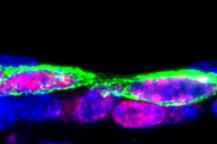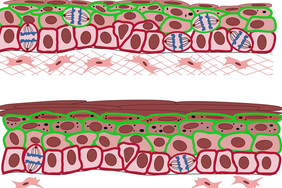
High proliferation (red) of both basal and suprabasal (green) cells in the stratifying skin epidermis at embryonic day E14.5. | picture: Lisa Wirtz

Scheme of skin development First phase: high proliferation in basal cells (red lining), high proliferation in supra basal cells (green lining), delamitation Second phase: decrease of proliferation in basal cells, almost neglect able proliferation in supra basal cells, delamination ? | Scheme: Bazzi lab
The complex layering (stratification) of skin arises form one layer of cells during embryonic development. How stratification is stimulated and driven is still largely unknown. Together with his team, Dr Hisham Bazzi, research group leader at the Cluster of Excellence in Aging Research CECAD and the Center for Molecular Medicine Cologne (CMMC), has published a new two-phase model of physiological epidermal development. Using time-lapse imaging and measurements of tissue growth dynamics in mouse models, the research team suggests that the first phase is the major phase of stratification, which is characterized by particularly high cell divisions or high proliferation rates.
This applies both to basal progenitor cells, the later stem cells of the skin, and to overlying skin cells, the suprabasally-commited skin cells. In addition, the so-called delamination, the detachment and movement of the basal cells to the suprabasal layers, contributes to the stratification. The article ‘High proliferation and delamination during skin epidermal stratification’ has now appeared in Nature Communications.
‘We were surprised to see many dividing cells not only in the basal layer, where the future stem cells are located, but also in the cells above it that are committed to differentiation. The crowded environment pushes cells to leave the basal layer and form new layers,’ said Bazzi. ‘This is probably a general paradigm for the formation of other layered tissues or even pseudostratified epithelia, a single row of cells that appears multilayered through the staggering of the nuclei.’
Further experiments showed that the second phase, a maintenance phase, is likely supported by cellular detachment from the basal layer rather than by the division orientation of the basal progenitors. This is different from the previously proposed mechanism suggesting that thin skin arises from parallel cell division and thick skin arises from perpendicular cell division.
Understanding the basic mechanisms of developing skin is the foundation for clinical research and will allow researchers to better understand skin diseases such as psoriasis and atopic dermatitis. ‘Encouragingly, we were able to demonstrate that there is also a high proliferation of suprabasal cells in samples from patients with psoriasis and atopic dermatitis. This suggests that programs from the developmental phase are reactivated in these diseases,’ said Lisa Wirtz, a doctoral researcher in the group.
Publication
Mareike Damen, Lisa Wirtz, Ekaterina Soroka, Houda Khatif, Christian Kukat, Benjamin D. Simons & Hisham Bazzi: High proliferation and delamination during skin epidermal stratification. https://www.nature.com/articles/s41467-021-23386-4 / https://doi.org/10.1038/s41467-021-23386-4
Media Contact
Dr. Hisham Bazzi
+49 221 478 84385
hisham.bazzi[at]uk-koeln.de
CMMC assoc. Research Project A02: The molecular pathways regulating skin morphogenesis and regeneration
Press and Communications Team
Dr. Anna Euteneuer
anna.euteneuer[at]uni-koeln.de